
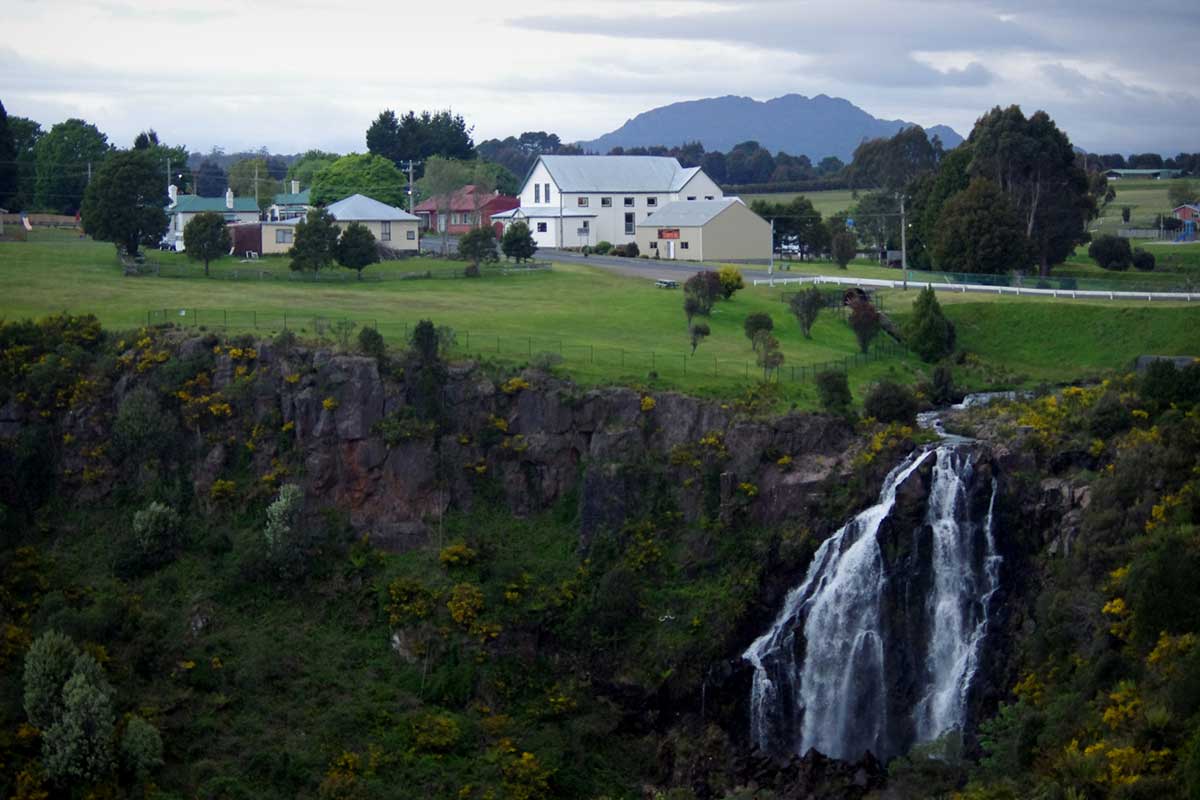
Waratah - Hellyer Gorge Drive: Burnie to Waratah
The town of Waratah was constructed to support a tin mine at Mount Bischoff. The town is built at the top of a waterfall, and water was diverted from the stream to provide water for mine sluicing and processing. Thanks to the altitude, Waratah experiences snow a few times per year, and has cool summer temperatures on par with some of the mainland ski areas, except with more rain. It's not the coldest or highest inhabited land in Tasmania, but it’s one of the highest and coldest places that resemble a conventional town. At the 2006 census, Waratah had a population of 227. It was also the first town in Australia to have electric street lights in 1886. At the Australian federal election, 2007, the polling place at Waratah Primary School registered a total of 148 votes.
Where is it?: West. Waratah is 232 km west of Launceston; 356 north west of Hobart; 70 km south west of Burnie.

The town of Waratah is built around the shoreline of Lake Waratah. It is pleasant central point in the town with picnic and barbecue facilities and walks to the falls (just north of Smith Street) and the dam wall near William Street. Make sure to go over the road and inspect the Waratah Falls and the waterwheel. Not far from Waratah, on the road west, is a rainforest walk to the Philosopher Falls.
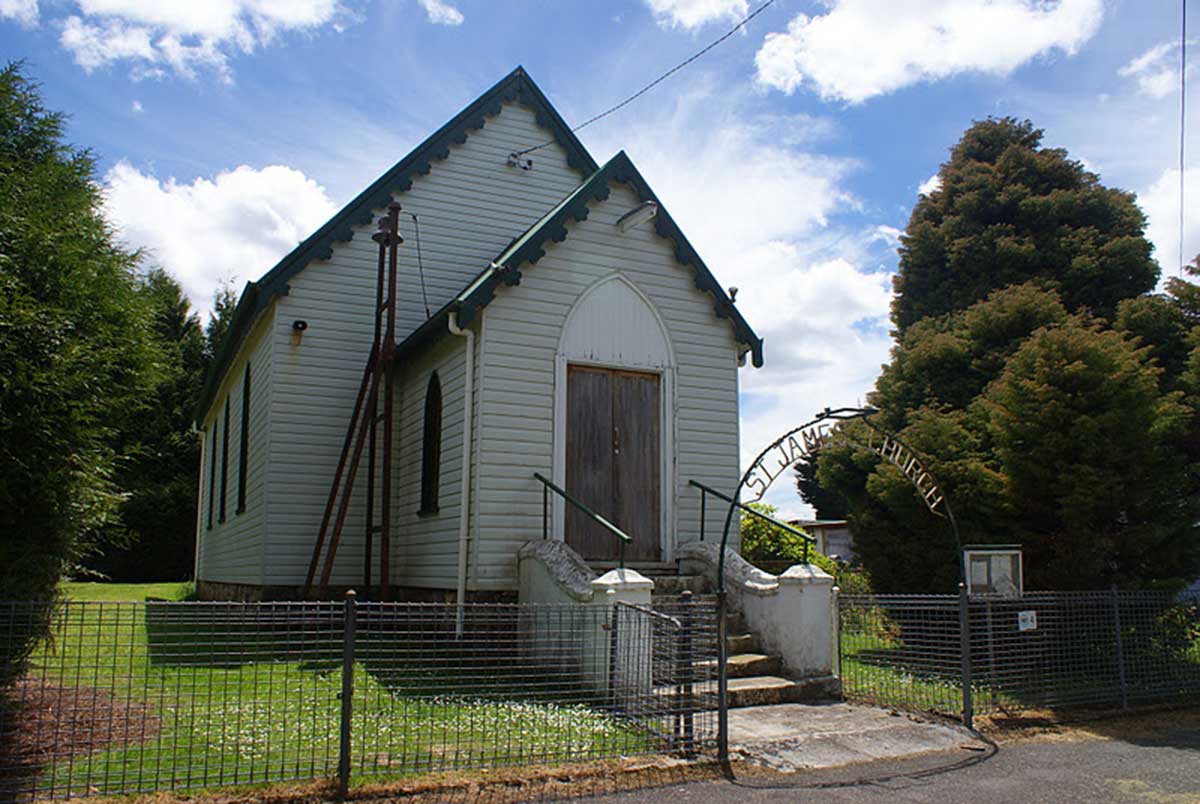
Waratah's 19th century prosperity is perfectly expressed in St James Church which was built in 1880. In 1889 the Mt Bischoff mine was being lit by electricity. The mine manager, H.W.F. Kayser had the electric light connected to the church. Thus St James became the first church in Tasmania to use an electric light. The church is located in Smith Street.
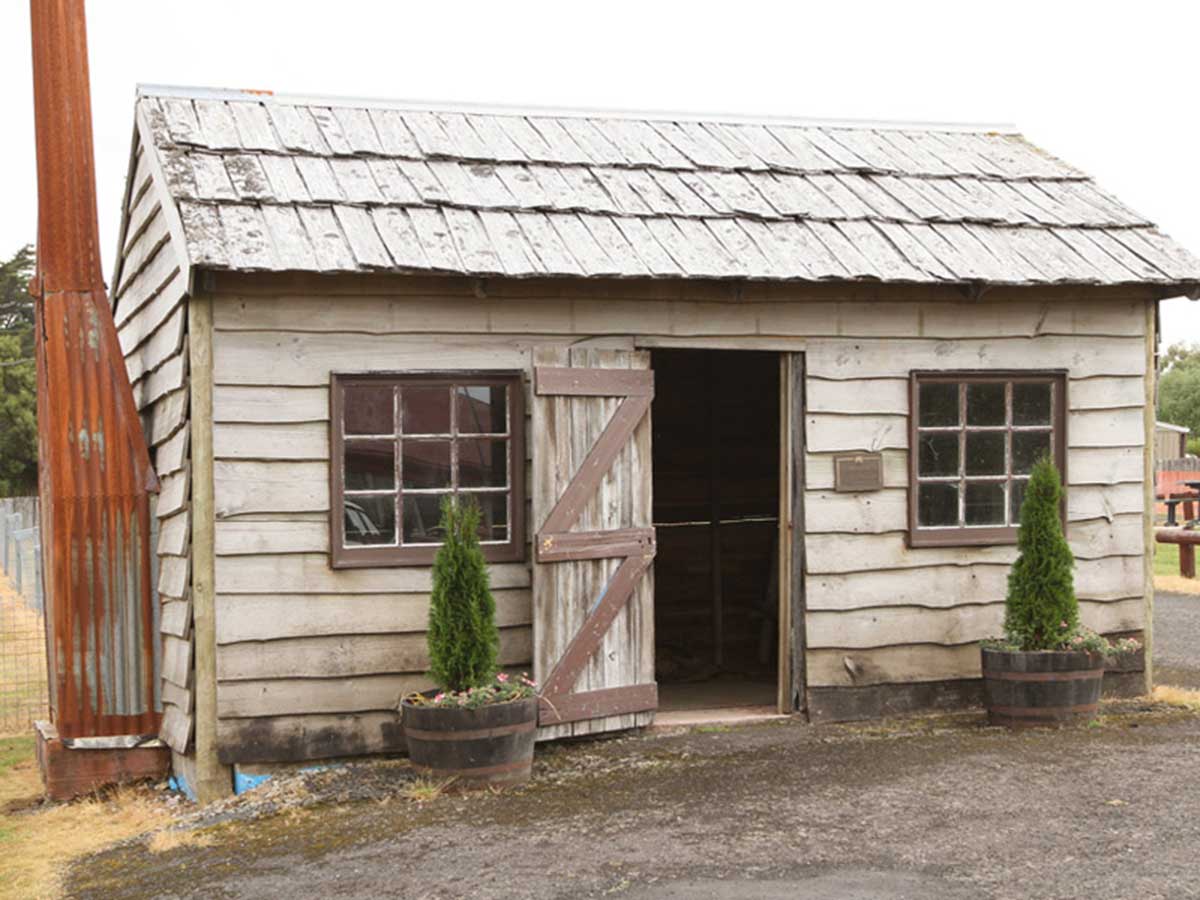
Philosopher Smith's Hut
Athenaeum Hall is a restored 1887 hall which served as a town hall among other things. Today it houses a great collection of historic photos which bring to life the history of the area. It also includes the Tarkine Interpretation Centre, designed to whet appetites for the wilderness nearby. Next door is the fully restored and operational stamper mill, once used for crushing tin ore. Also nearby is Philosopher Smith's Hut, a replica hut which shows the humble living conditions of the early pioneers.
Waratah Pioneer Cemetery is situated 4kms from the township. Signposted on the left side of the road 3 kms from the turnoff at the Ridgley Hwy. There are only 91 people mentioned on the headstones today as many headstones have been removed due to damage over the years.
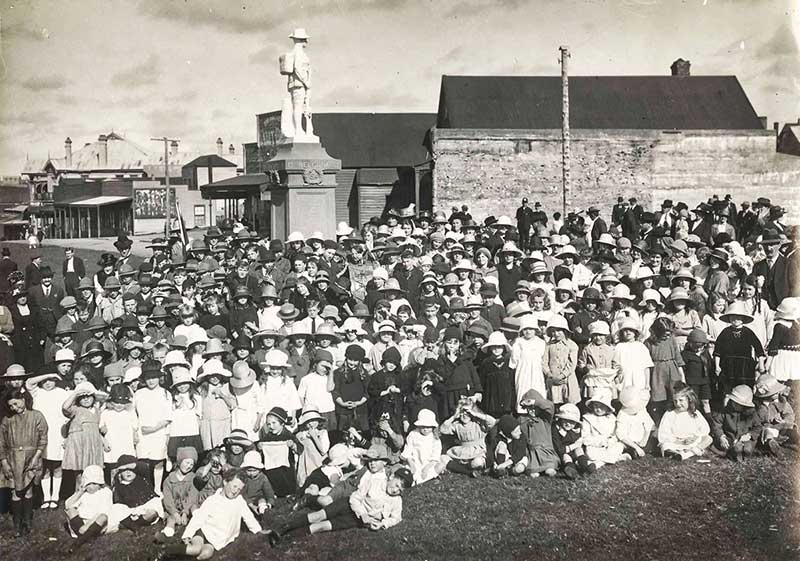
Anzac Day, 1922
Mount Bischoff is a mountain and former tin mine in the north-western region of Tasmania. The mountain is situated adjacent to Savage River National Park. The mine operated successfully at first by the Mount Bischoff Tin Mining Company, using sluicing with water from the top of the waterfall in Waratah. In June 1883, the mine installed one of the first hydro-electric generators in Australia and employed it to light the offices, workshop and manager's house. The easy ore was all extracted by 1893 when sluicing was discontinued. Mining continued opencut on the face of the mountain, and underground. The manager of the mine from 1907 to 1919 was John Dunlop Millen; he was "credited with the modernisation of the mine’s facilities and was regarded by all those associated with the mine’s operations as an effective manager". The underground mine closed in 1914, but surface mining continued for some time before it also ceased after the price of tin slumped in 1929. The mine was reopened by the Commonwealth Government in 1942 to support the war effort, but it finally closed in 1947. The mine was connected to the Emu Bay Railway by the Waratah Branch of that railway which was run from Guildford Junction to Waratah between 1900 and mid 1940.

After several minor attempts, in 2008 Metals X Limited, a Perth-based mining company, through its subsidiary Bluestone Mines Tasmania Pty Ltd, the operator of the Renison Bell, one of largest tin mines in the world today, decided to mine the remaining tin at Mount Bischoff to blend with ore at its Renison Bell operation. A large open cut operation taking in all the old historic workings was developed at Mount Bischoff for this purpose with the ore being trucked 80 kilometres to the Renison Bell processing plant. At the time ore reserves at Mount Bischoff were estimated to be 845,000 tonnes grading at 1.20 percent tin. In 2009/10 198,000 tonnes of ore was mined at the Mount Bischoff open pit that produced 6,267 tonnes of tin in concentrate. The open cut mine at Mount Bischoff is currently on care and maintenance. Bluestone Mines Tasmania Pty Ltd is continuing its exploration program at Mount Bischoff.
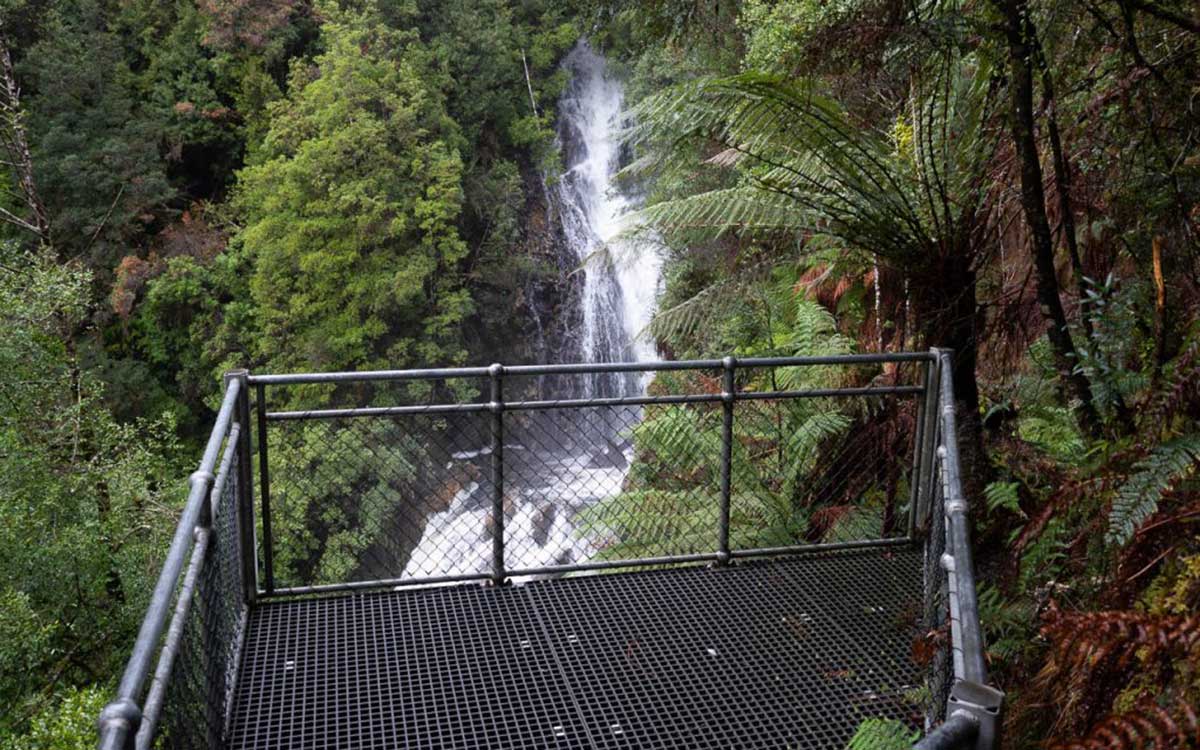
Previously closed to the public, the track has been upgraded and leads to a viewing platform near the falls. Good fitness is required as the downhill gravel walk takes 40 minutes each way and descends 240 timber steps. Well worth the effort, it is well signposted from the turnoff at the road and impossible to become lost.
Location: the upper reaches of the Arthur River, 10km from Waratah.
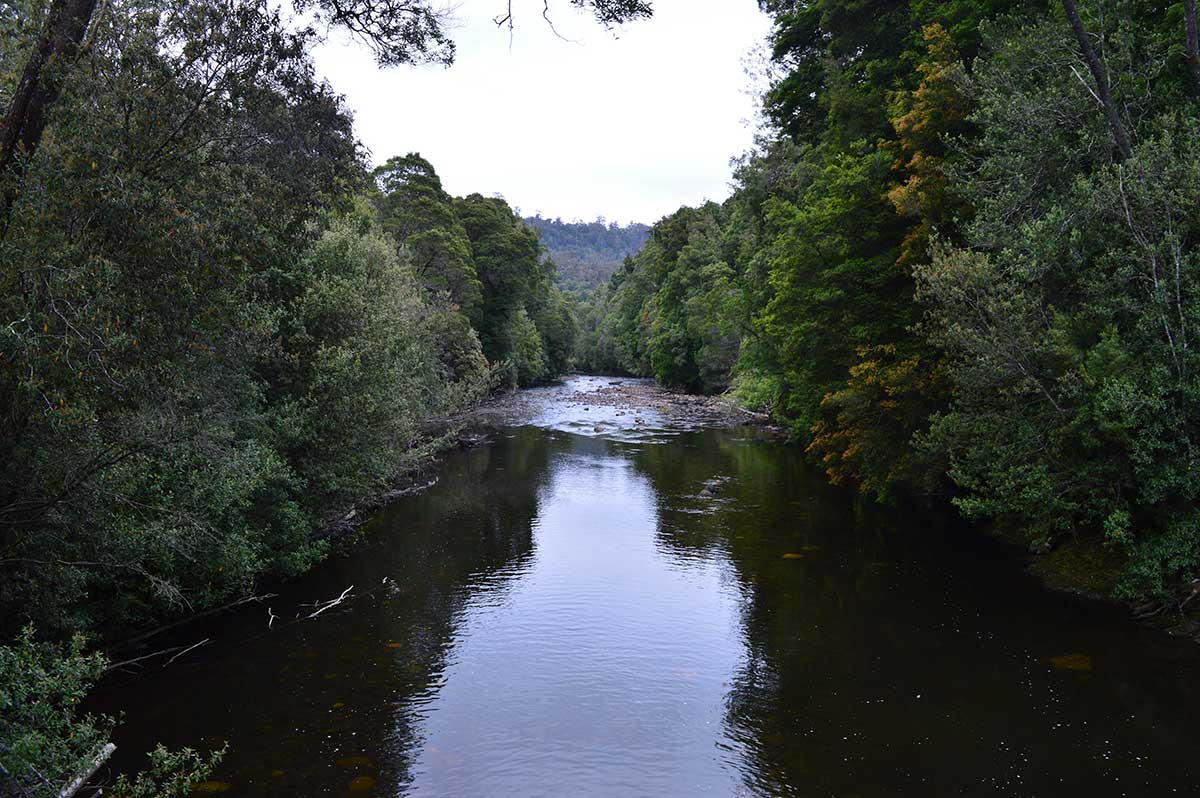
Hellyer Gorge is steeply winding gorge of the Hellyer River, through which flows the Hellyer River. The Murchison Highway passes through the area with many sharp and steep bends, which provides the setting to a stage of Targa Tasmania.
A delightful wayside stop at the Gorge on the Murchison Highway south gives the opportunity for travellers to stop and explore a section of rainforest of tall myrtle beech, encrusted with mosses, fungi and epiphyte orchids. A number of walking tracks along the banks of the Hellyer River (near the rest area) provide a pleasant walk to refresh before journeying on. It is situated in the heart of a mountainous and heavily forested area, near one of the visually most impressive sections of highway in Tasmania.
Where is it?: Off the Murchison Highway on the way south to Waratah, 52 km south of Burnie; 128 km north of Queenstown.


Hellyer Gorge and the river which flows through it are named after Henry Hellyer (1790-1832), an English surveyor who was one of the first explorers to visit the rugged interior of the north west of Tasmania, and made the most comprehensive maps of the area up to that time. When the Van Diemen’s Land Company (VDL Co) was formed in 1825 he was one of the first officers to sign on, as a surveyor (later Chief Surveyor) and Chief Architect. His achievements in Tasmania are well documented.
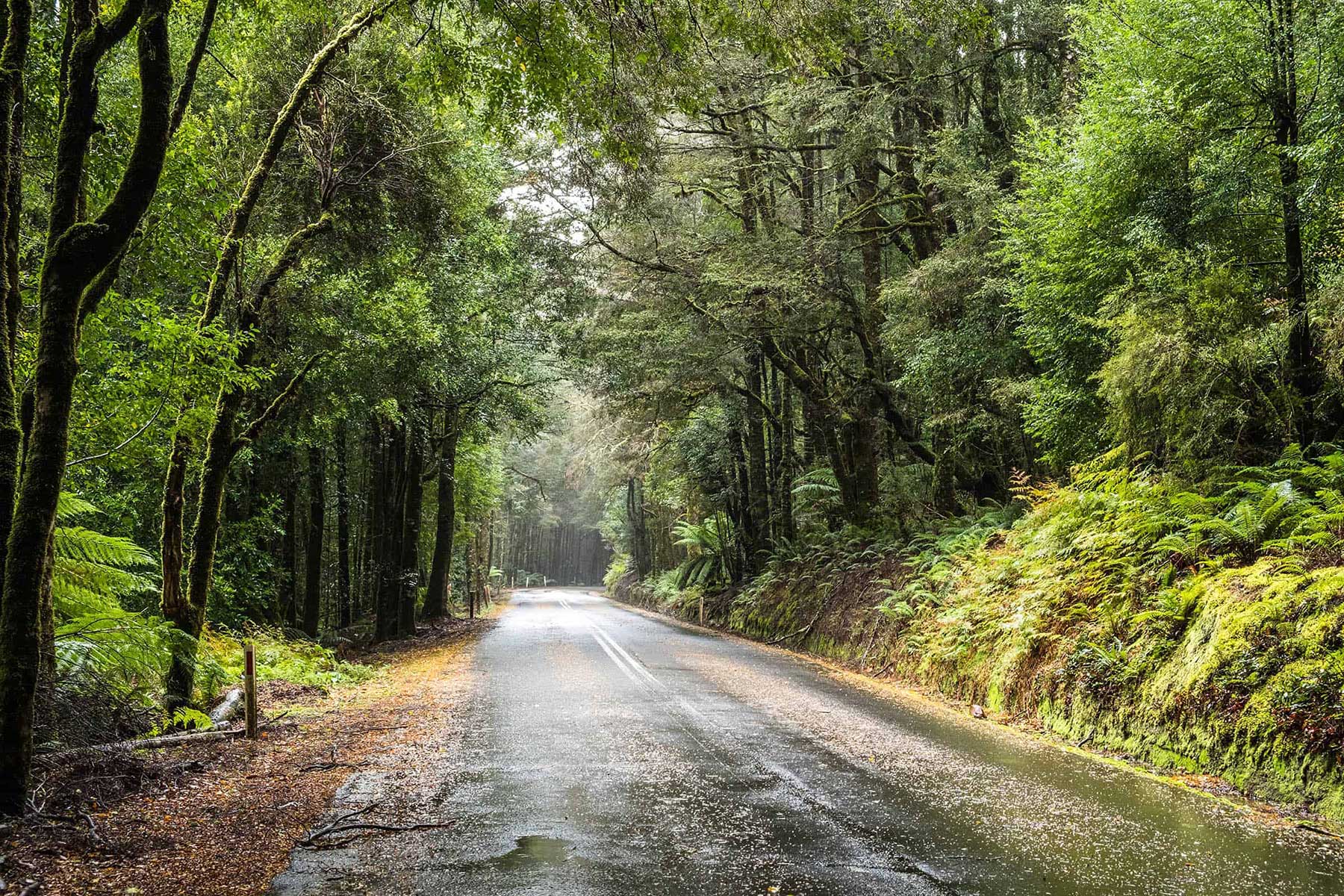
The road from Watatah to Hellyers Gorge is one of the prettiest rainforest drives in Tasmania
The gorge is protected byf the Hellyer nGorge State Reserve. The Murchison Highway passes through the area with many sharp and steep bends. Being subject to ‘black ice’, this portion of road has now been bypassed by the newer Ridgely Highway. Nevertheless, the area is quite picturesque and some bush-walking tracks have been blazed for tourists. Hellyer Gorge is off the Murchison Highway to the south to Waratah, 52 km south of Burnie; 128 km north of Queenstown.
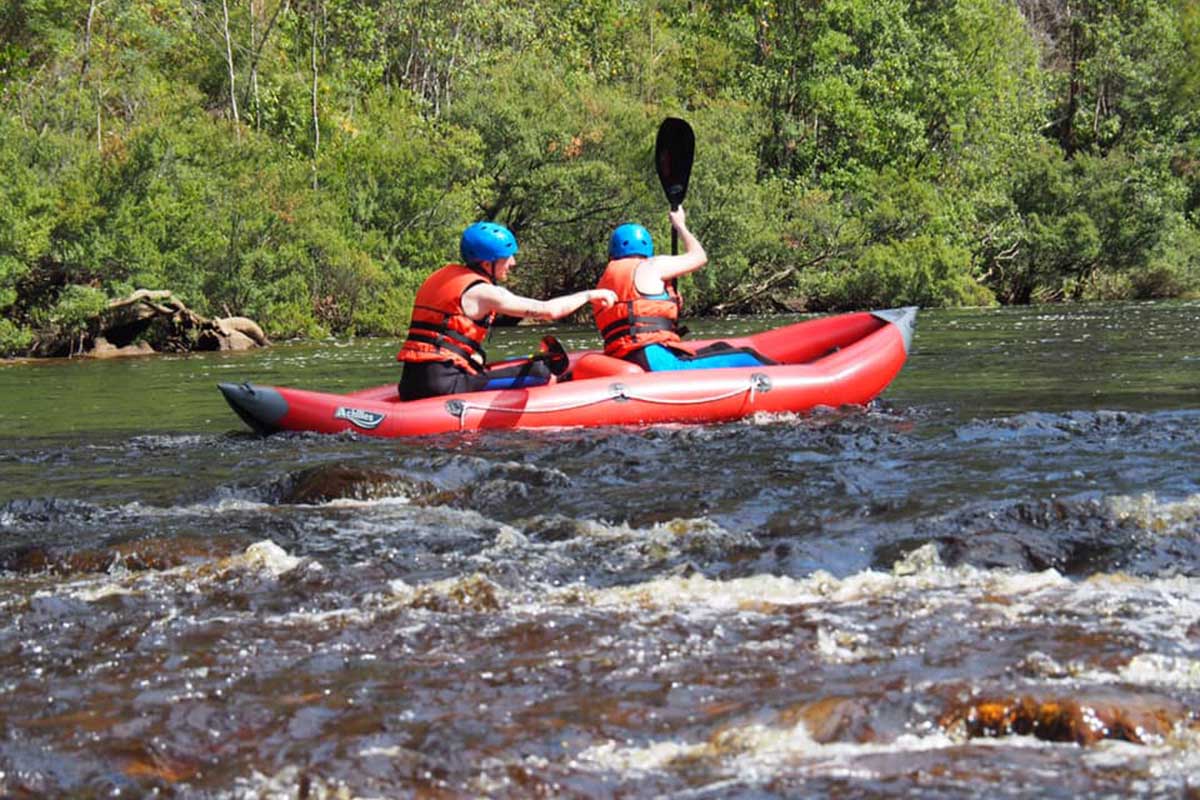
There are a number of sections of the Hellyer River that are suitable for kayaking.
Hellyer River from the gorge: Enter at the Murchison Highway Bridge on the Hellyer Gorge and travel downstream 13 km to Blackwell Road Bridge. Exit at the Blackwell Road Bridge over the Hellyer River. The river consists of small drops and easy grade 2 rapids. It flows through some beautiful rainforest.
Hellyer River above Link Road: A 5m run, commencing at Chilton Bridge and exiting at the bridge over the Hellyer River on the Hampshire to Murchison Highway Link Rd. On this 5km section, the river drops very steeply with a series of vertical falls. There are a number of very tricky sections and at high water, these could be very difficult.
Hampshire Link Road to Hellyer Gorge: begin from the bridge over the Hellyer River on the Hampshire to Murchison Highway Link Rd and exit at the Murchison Highway Bridge in the Hellyer Gorge. This 16 km section of river runs through very steep country and it drops continuously with many good grade 3 rapids. The rapids are very close together and log jams are always a danger. There are a number of small waterfalls in the first 5 km several of which usually need portaging as they contain logs. Inspection is necessary as a walk out is horrendous. The river can be very cold and an early start is recommended. The last 5 km are grade 2.
Hellyer Lower – Blackwell Road Bridge to Farquhars Bridge: a 15 km run from Blackwell Road Bridge over the Hellyer River to Farquhars Bridge.

Magnet Mine Trail
The old Magnet mine is located six kilometres directly west of Waratah, although access is by a somewhat circuitous route. The mine has been intermittently worked for silver, lead and zinc for many years, and more recently for specimen minerals. The site is reached by traversing an unsealed road (the Magnet Road) leading off the sealed Waratah Road opposite Whyte Hill (on which a Telstra tower has been erected). This junction is approximately 12 km west of Waratah. The track is steep and badly eroded and is best restricted to 4WD vehicles.
The Trail begins 1.75km west of Waratah and traverses lush rainforest on its way to the Magnet mine site. The mine site has relics to explore and good places to camp. You can create a circular route using local roads, particularly if cycling. A great walk if you have the time and energy.
Distance: 16km.
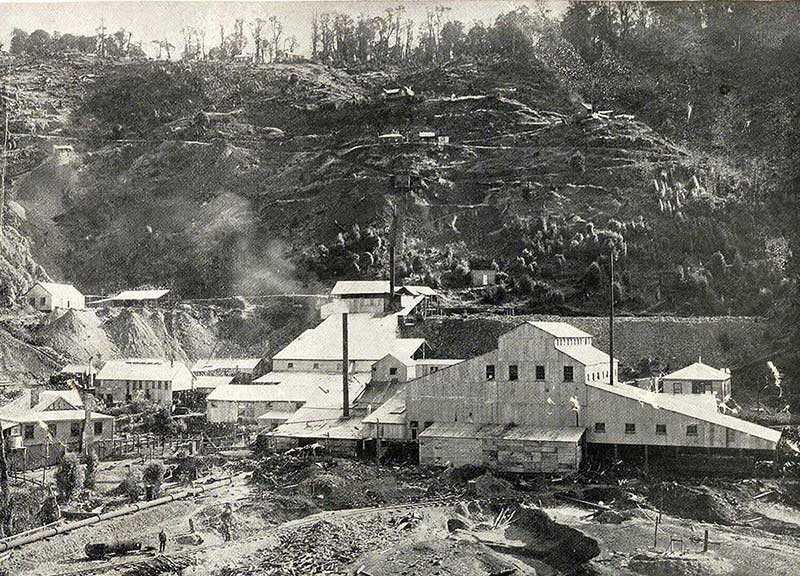
Magnet silver Mine c1913
The area around the old Magnet mine is a recognised fossicking area. The main collecting area is the ferromanganese gossan, which is located above the ruins of the old mill beside the access road (at AMG reference 370 100 mE, 5 410 650 mN). The collecting point is reached after travelling approximately 3 km along the unsealed road and passing through a gravel pit. The main collecting area is the ferromanganese gossan, which is located above the ruins of the old mill beside the access road. The collecting point is reached after travelling approximately 3 km along the unsealed road and passing through a gravel pit. The Magnet Road continues back to Waratah, but is almost impassable due to washouts.
More about Magnet and the Magnet Mine

Mt Stewart mine tunnel entrance
Mt Stewart Mine, also known as the Long Tunnel Mine, is an abandoned small silver-lead-zinc mine near Luina, about 25km SW of Waratah. Located just off theCastray River, it was one of the westernmost mines in Tasmania. The Mt. Stewart lode, located some distance to the oouth-west of the Heazlewood and the Whyte River district, was discovered in 1890. A a main shaft was completed to 212 feet. Access to the mine was at first gained by means of a pack-track. About the year 1905, a wooden tramway, 9 km in length, was constructed in order to reduce cost of transport of the ore from the mine. After the cessation of work in 1912, the tramway fell into a state of general disrepair, and was again used as a pack-track, forming the only means of communication with the Mt. Stewart and neighbouring oemiridium field.
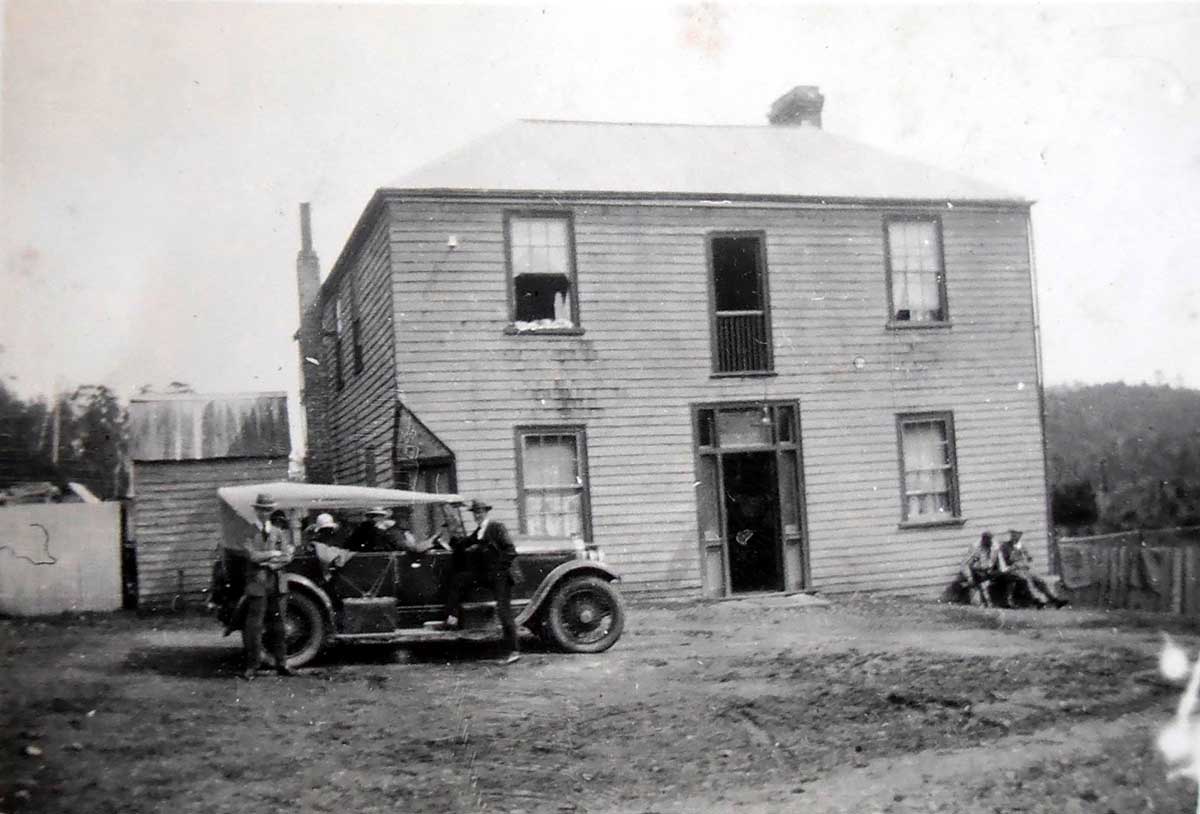
Whyte River Hotel, Luina
A tiny tin mining town on the Whyte River, Luina (17 km west) has twice come into existence as a result of the osmiridium, gold, silver-lead, copper and tin deposits in the area. Luina was gazetted as a locality in 1966. Previously known as Whyte River, the current name was in use by 1914. It is believed to be an Aboriginal word for “blue headed wren”. Today it is nothing more than a ghost town, with a few streets, some gutters and culverts being all that remain where once there were houses.
In 1908, a 10-head battery of stamps and concentrating machinery was erected by the Mt Cleveland Tin Mining Co. to treat high grade non-pyritic ore. A short 20 metre long tramway right of way linked the upper battery adit at the Number 3 lode workings to theore bins/primary crushing precinct at the Cleveland mill. The only remains of the tramway today consist of a five metre long dry stone retaining wall which prevented the embankment from collapsing in to the adjacent mill excavation.
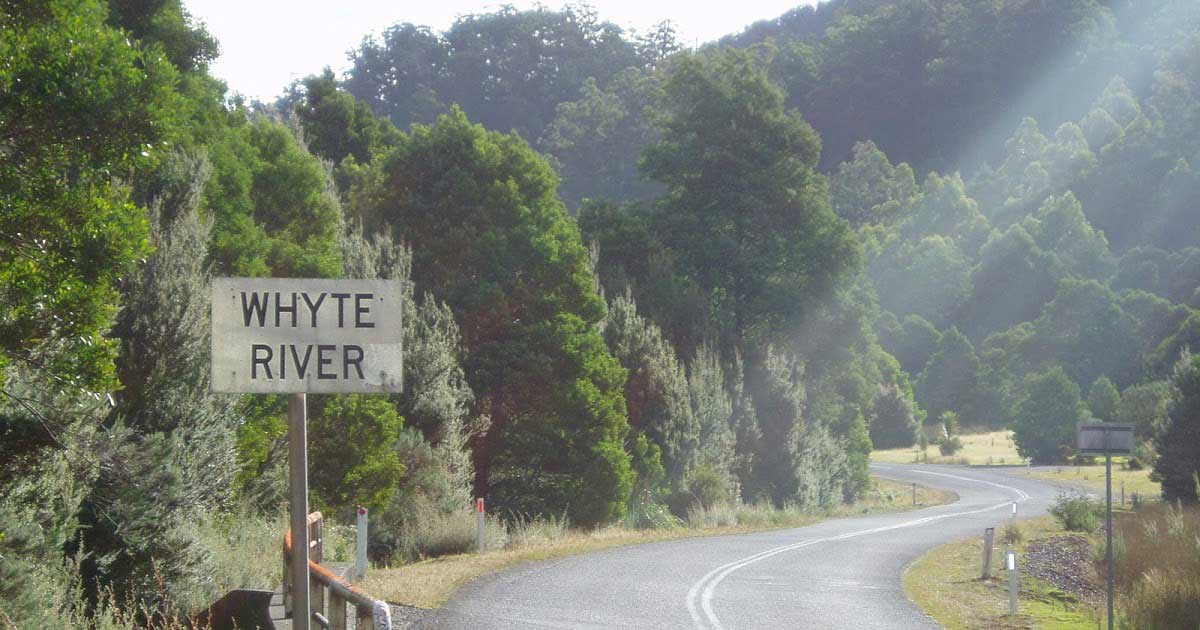
By the end of World War I the copper-tin mining operation had closed down and it wasn't until 1967, when Cleveland Tin NL poured millions of dollars into the area and built a company town of over 60 houses, that Luina returned to life. The basis of the town's economic success was the establishment of the Mount Cleveland Tin Mine. By the early 1970s Cleveland Tin NL had become the second largest tin producer in Australia.
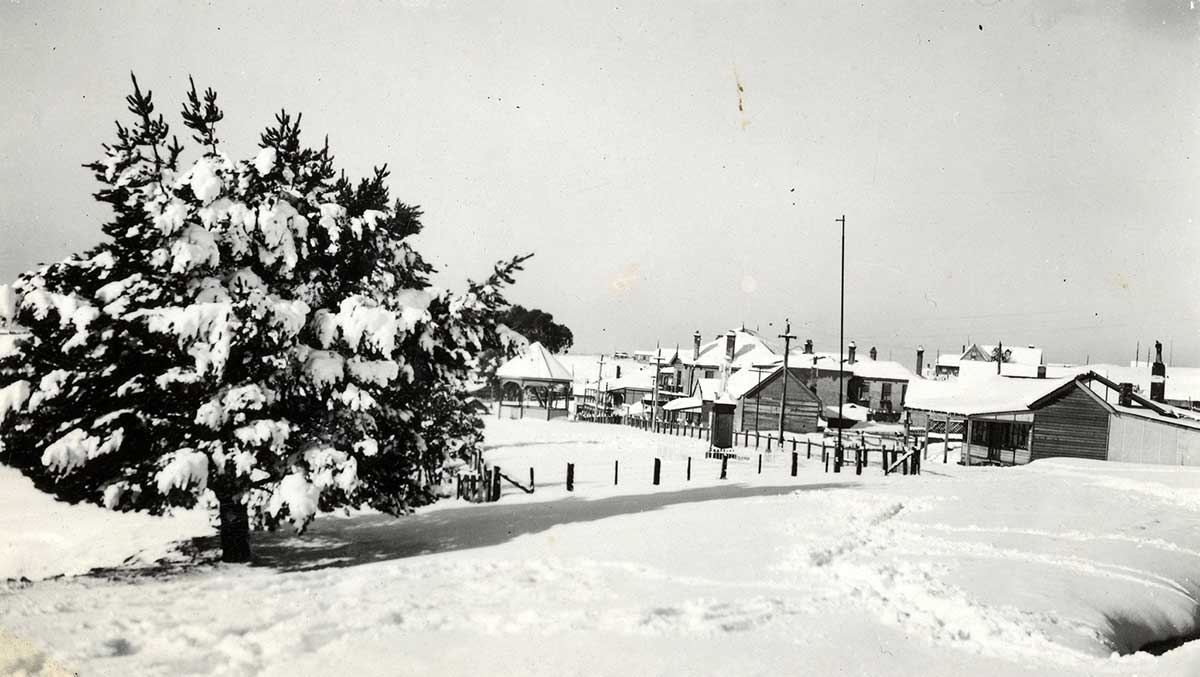
Waratah in winter, c1910
The Mount Cleveland mine had a production capacity of about 450,000 tonnes of ore a year for the recovery of about 1500 tonnes of tin in concentrate and about 500 tonnes of copper concentrate. It produced some of Australia's best fluorite and vivianite specimens and some rare fluorides. The mine closed in 1986. This site is one of the best preserved concentrating mill sites in Tasmania boasting an in situ selection of historic milling machinery rarely seen today. In addition to this machinery, the site itself remains well defined and assuch still conveys the manner in which historic ore dressing operations were conducted at this site.
Luina is located 131 km north of Queenstown, 89 km south of Burnie and 21 km east of Savage River. It can be located on the south side of the Whyte River.
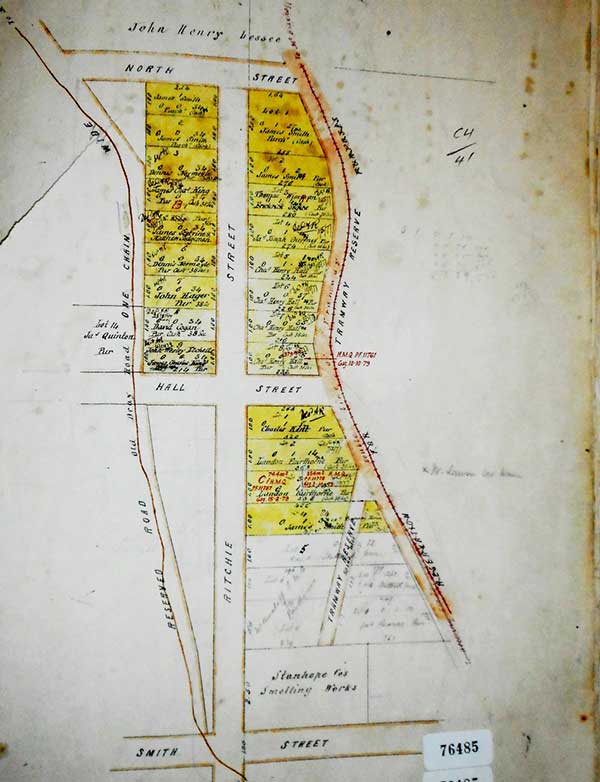
Charles Sprent's survey map of Waratah, 1876
Van Diemen’s Land Company explorer Henry Hellyer named the nearby Magnet Range because it interfered with his compass. The suspicion that it contained a mineral lode was confirmed by the prospector William Robert Bell six decades later when he uncapped a lode of silver-lead.
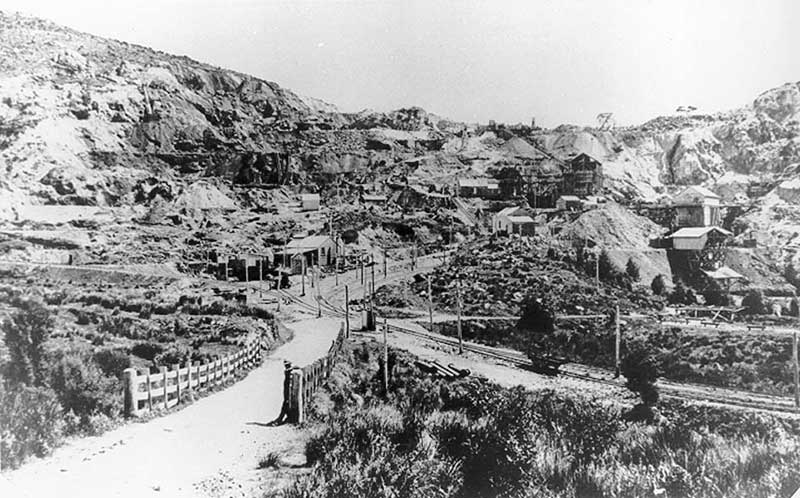
Mount Bischoff Mine
Tin was discovered at Mount Bischoff by James "Philosopher" Smith in 1871. The mine operated successfully at first. The easy ore was all extracted by 1893 when sluicing was discontinued. Mining continued open cut on the face of the mountain, and underground. The underground mine closed in 1914, but surface mining continued for some time before it also ceased after the price of tin slumped in 1929. The mine was reopened by the Commonwealth Government in 1942 to support the war effort, but it finally closed in 1947.
During its mining heyday, Waratah was attached to the outside world by only a two-feet-gauge tramway so circuitous that it turned six kilometres as the crow flew into sixteen, spread over 142 bends. To appreciate the full level of the town's isolation it is worth remembering that the road through the area was not completed until 1963.
The town of Waratah was constructed to support the tin mine at Mount Bischoff. Mount Bischoff Post Office opened on 1 September 1874 and was renamed Waratah in 1882. The town takes its name from the Waratah River, a tributary of the Arthur River, which, in turn, was named after the wildflower that was found growing in the area. The river was probably named by Van Diemen's Land Company officials during an exploratory trek through the area. The town was surveyed by Charles Percy Sprent in 1876. He was the District Surveyor of the North-western District of Tasmania from 1871 to 1882. During those years, Sprent did valuable pioneering work in opening the way for prospectors by his explorations of the country lying between Mount Bischoff and Macquarie Harbour. In 1876 he penetrated the mineral belt to the east of the Meredith Range, between Waratale and the Pieman, cutting a track through a dense tangle of scrub and forest. His explorations did much to assist the opening up of the rich mineral resources of Western Tasmania. Sprent is recalled in one of the town's street names.

Magnet Tramway, early 1900s

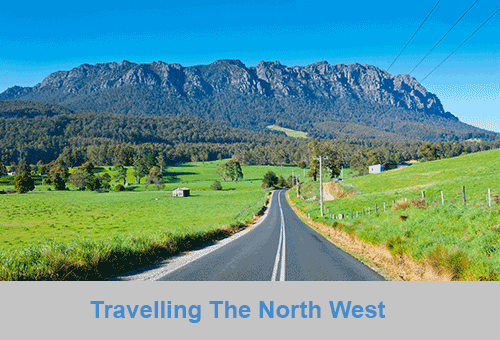
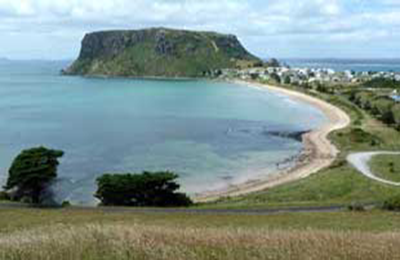
North West Coast
The North West coast extends from Burnie all the way west to Cape Grim, Tasmania's rugged north-west corner. Along the way are the beachside towns and villages of Wynyard, Boat Harbour Beach, Stanley and Smithton, as well as the rugged volcanic headlands od The Nut (Circular Head), Rocky Cape and Table Cape.
Full Itinerary


Central Coast
The first European settlement of Tasmania's Central Coast commenced in the 1840s, the rich basalt soil proved ideal for cropping, and today agriculture is the principal contributor to the area’s economy. Motorists travelling along the north-west of Tasmania are well served by the National Highway. Central Coast, however, is fortunate to have retained a small section of ‘old highway’. This scenic coastal detour hugs the headlands and sandy shores from Ulverstone through to Howth and is well worth the extra time taken to travel this scenic route.
Full Itinerary


Central Hinterland
Boasting rolling farmland, the hinterland of Tasmania's central coast is home to some of the region's finest agriculture and local produce, its narrow roads making their way through lush farmlands on their way to the alpine terrain of Cradle Mountain. The area is world-renowned for its bush-walking, mountain ranges and canyons, and laid-back small towns set againt mountainous backdrops.
Full Itinerary


North West Hinterland
The area is dominated by the Tarkine, a wilderness area containing a wildly diverse landscape, a world of natural treasures including Australia's largest patch of temperate rainforest, mountain ranges, wild river and cave systems and buttongrass moorlands. Waterways can be explored by canoe, kayak and riverboat cruises through forests of blackwood, myrtle and celery top pine all the way to the sea.
Full Itinerary


Meander Valley
Set against the backdrop of the Great Western Tiers, the Mradner Valley is located at the western end of the Central Coasy Hinterland, located midway between Launceston and Devonport. Dotted among the farms of the area are numerous small towns, each with their own individual character and colonial-era charm. Deloraine, on the banks of the Meander River, has become a centre for artists and craftspeople, drawn by the lifestyle and inspired by the stunning scenery.
Full Itinerary


West Coast
2 to 3 hours drive from Devonport and Burnie, Tasmania's West Coast region is made up of serene natural harbours, rugged coast, densely forested mountain ranges, fast flowing rivers, steep gorges, rainforest wilderness and ghost towns. The region has some of the most pristine and beautiful wilderness in the world, encapsulated in the World Heritage listed Franklin-Gordon Wild Rivers National Park. Bushwalkers are rewarded by spectacular nature sights. Even the less energetic can enjoy the untouched rainforests while cruising the Gordon and Pieman Rivers.
Full Itinerary
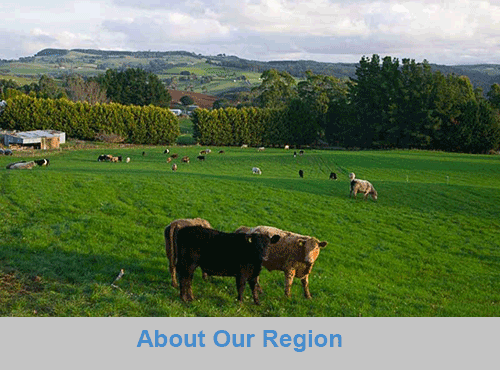
The North West region of Tasmania covers a vast area including the towns of Devonport, Burnie, Cradle Mountain National Park and the Tasmanian west coast as far south as Strahan and Queenstown. The gateway to this region is Devonport, with an airport and the Spirit of Tasmania (ferry between Victoria and Tasmania) terminus. The port handles much of the export produce from the rich agricultural areas around Devonport. The town itself is used as an arrival or departure port for most travellers rather than a destination itself.
A major farming area stretches from Devonport along the coast to Stanley. Many of Australia's finest vegetable and dairy produce come from this region. Stanley is an historic fishing village with a large volcanic headland - The Nut - accessible by chairlift. Far out to the north-west in the stormy waters of Bass Strait, King Island consists very much of uninhabited bushland teeming with wildlife. The island produces some of the best dairy products, for which it is famous.
Cradle Mountain-Lake St Clair National Park, in Tasmania's World Heritage Wilderness Area, offers a rugged environment with many wilderness retreats and walking tracks. Icy streams, ancient pines, glacial lakes and wildlife surround the jagged contours of Cradle Mountain. The area is one of the most glaciated in Australia and includes Tasmania's highest mountain, Mt Ossa (1617 metres) and Lake St Clair, Australia's deepest natural freshwater lake, the source of the River Derwent.
The West Coast area of Tasmania is made up of rugged coast, mountain ranges, flowing rivers, steep gorges, rainforest wilderness and ghost towns. Strahan is situated on Macquarie Harbour and is the starting point for Gordon River cruises and air tours over the South West Wilderness. Strahan is the only town on this rugged and dangerous coast.













